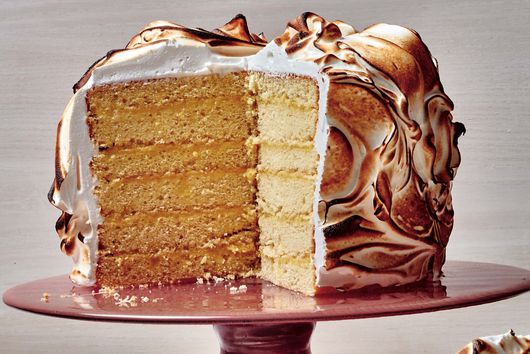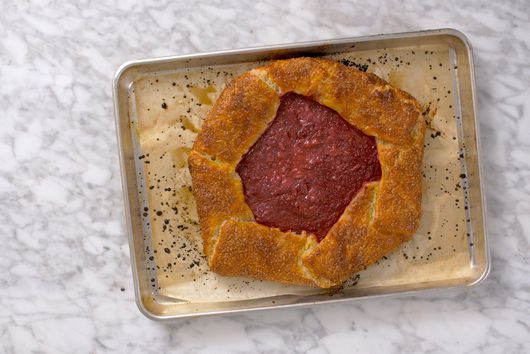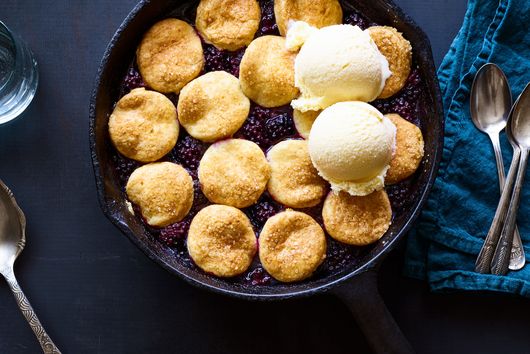Claire Saffitz's Preserved Lemon Meringue Cake
★★★★★
PREP TIME
5 hours 10 minutes
COOK TIME
10 minutes
SERVES
10
Ingredients
3
whole small preserved lemons (about 6 ounces/170 grams)
3/4 cup
plain whole-milk Greek yogurt (6.3 ounces/180 grams), at room temperature
1 tablespoon
baking powder (0.42 ounces/12 grams)
1/4 teaspoon
baking soda
1/3 cup
neutral oil, such as vegetable or grapeseed (2.6 ounces/75 grams)
2 cups
sugar (14 ounces/400 grams)
3
large egg whites (3.7 ounces/105 grams)
1/2 teaspoon
fresh lemon juice
1 teaspoon
vanilla extract or orange blossom water
Instructions
- Preheat the oven and prepare the pans: Arrange two oven racks in the upper and lower thirds of the oven and preheat to 350°F. Lightly butter the bottoms and sides of the cake pans and line the bottoms with rounds of parchment paper, smoothing to eliminate air bubbles. Butter the parchment and set the pans aside.
- Blend the lemon into the wet ingredients: Halve the preserved lemons and pull out and discard the pulpy innards and seeds, leaving only the rind. Rinse and coarsely chop the halves, then weigh and measure the amount. You should have about 3 ounces/85 grams or a scant 1/2 cup. In a blender, combine the chopped preserved lemons, yogurt, lemon juice, vanilla, and grated zest and blend on low speed to liquefy, then on high until the pieces of lemon rind disappear and the mixture is smooth. Set the mixture aside.
- Add the eggs: Reduce the mixer speed to medium and add the eggs one at a time, beating well after each addition. Beat on medium-high until the mixture is very light and thick, about 1 minute.
- Alternate the dry and wet ingredients: With the mixer on low speed, add about one-third of the flour mixture and mix until the flour has almost disappeared. Scrape in half of the yogurt mixture, mixing just until incorporated, then add the remaining flour in 2 additions, alternating with the remaining yogurt mixture. When the last traces of flour disappear, stop the mixer and remove the bowl. Use a flexible spatula to scrape down the sides and fold the batter several times to make sure it’s evenly mixed.
- Fill the pans and bake the layers: Divide the batter among the three prepared pans (if you have a scale, weigh out 1 lb 3 oz / 539g of batter per pan). Smooth the batter in an even layer all the way to the sides. Transfer the pans to the oven, placing two on the upper rack and one on the lower rack, staggering so the pan below doesn’t have another pan directly above it. Bake the cakes until the centers spring back when pressed, the surface is golden, and a cake tester or toothpick inserted into the centers comes out clean, 25 to 30 minutes, switching racks and rotating the pans front to back after 20 minutes.
- Cool the cakes: Remove the cakes from the oven and let them cool completely in the pans.
- Split the layers: Use a small offset spatula or paring knife to cut around the sides of the pans to loosen the cakes. Invert them onto a wire rack, peel off the parchment, then reinvert onto a cardboard cake round or cutting board. The cakes should bake very flat so you won’t need to level them. You are, however, going to split the layers in half horizontally to make six thinner layers out of the three.
- Holding a serrated knife horizontally, mark the midway point around the side of a cake by making shallow score marks all the way around. Then, using long, even strokes and positioning the knife parallel to the work surface, follow the shallow cut as a guide all the way around the cake to slice it into two even layers. Lift the top layer off the cake and set aside. Repeat with the remaining layers so you have six total.
- Stack, fill, and chill the layers: Place a cake layer, cut-side up, on a cake round, serving plate, or cake stand and slide several strips of parchment partially underneath and all around the cake to cover and protect the plate or stand during frosting. Using a small offset spatula, spread a slightly heaping ⅓ cup cold lemon curd across the surface, leaving a ½-inch border. Place another layer on top, cut-side up, making sure it’s centered. Press gently to level, then spread with another slightly heaping ⅓ cup curd. Repeat until you’ve stacked all six layers and used all the curd, placing the final layer cut-side down. The layers might start to slide around, so cover the cake with plastic wrap and carefully transfer it to the refrigerator to chill until the curd has firmed up and the layers are stable, about 20 minutes. You can also stick a skewer down the center of the cake through all the layers to hold them in place.
- Beat the meringue and cover the cake: Once all the sugar syrup has been added, increase the mixer to high and continue to whip until the meringue is very glossy and forms a firm peak off the end of the beater. Be careful not to overbeat or the meringue will become dry and take on a curdy texture, making it hard to smooth over the cake. Beat in the vanilla. Remove the cake from the refrigerator and uncover. Scrape all of the meringue over the top of the cake and smooth it across the surface and down the sides with an offset spatula, covering the entire cake and making lots of swirls.
- Torch, if desired, and serve: Slide the parchment strips out from underneath the cake. If desired, use a kitchen torch to toast the meringue all over before cutting the cake into slices and serving.
-
DO AHEAD The cake layers, well wrapped and stored at room temperature, will keep up to 2 days or can be frozen up to 1 month (split them in half horizontally before freezing). Fill and stack the frozen cake layers, then cover and let the cake thaw overnight in the refrigerator before covering with the meringue. The cake layers can be filled and stacked 1 day ahead; keep covered in the refrigerator. Let the cake come to room temperature and cover with the meringue just before serving. The coated cake will keep at room temperature for at least 1 day, but the meringue will deflate over time.
*If you don’t have or can’t find cake flour, in a pinch you can substitute an equal amount of all-purpose flour: Just replace 1 tablespoon flour with 1 tablespoon of cornstarch per 1 cup flour called for in the recipe.
**For a simpler spin on this cake, skip the Italian meringue and instead coat the layers in stiffly whipped, lightly sweetened cream just before serving.
Preserved lemon cake
- Beat the eggs and sugar in the saucepan: In a small, heavy-bottomed saucepan,** combine the sugar and lemon zest and use your fingertips to massage the zest into the sugar until the mixture is fragrant and looks like wet sand. Add the egg yolks and whole egg to the pan and whisk vigorously, making sure no unincorporated sugar is trapped around the sides, until the mixture is very pale, light in texture, and thick, about 2 minutes.
- Add the lemon juice and cook the curd: Slowly stream in the lemon juice, whisking constantly and scraping around the sides, until the mixture is smooth. Whisk in the salt. Place the saucepan over medium-low heat and cook, whisking constantly, until the curd turns opaque yellow, is thick enough to coat the back of a spoon, and barely holds the marks of the whisk (it will also register 170°F on an instant-read thermometer), 7 to 10 minutes. Immediately remove the saucepan from the heat.
- Whisk in the butter and vanilla: Whisk in the butter one piece at a time, waiting for each piece to disappear into the curd before adding the next, until all the butter is incorporated and the mixture is smooth. Whisk in the vanilla. ***
- Chill the curd until set: Scrape the curd into a medium glass or plastic bowl or container and press a sheet of plastic wrap directly onto the surface (this will prevent a skin from forming).****
- Refrigerate until the curd is cold and set, at least 3 hours.
- VARIATION Meyer Lemon Curd: Decrease the quantity of sugar to 2/3 cup (4.6 ounces/130 grams) and replace the regular lemon zest and juice with Meyer lemon zest and juice.
-
DO AHEAD The curd, covered and refrigerated, will keep up to 5 days.
*Finely grate the zest from the lemons before you juice them; it’s much easier than trying to zest juiced halves.
**Using a heavy saucepan with a thick bottom and sides will prevent the curd from heating unevenly and possibly overcooking in places. If you only have a thin, flimsy saucepan, you can still make this curd by stirring it in a large heatproof bowl set over a large saucepan filled with 1 inch of simmering water (don’t let the bottom of the bowl touch the water). Just note the curd will take longer to thicken because of the gentler heat.
*** I don’t strain lemon curd because straining removes the flavorful zest. But if for any reason you have lots of solid bits (where the egg likely curdled), it’s best to go ahead and strain.
****Don’t store the curd in a metal bowl, even one that’s nonreactive or stainless steel, as the curd will eventually acquire a metallic taste.
Lemon curd





